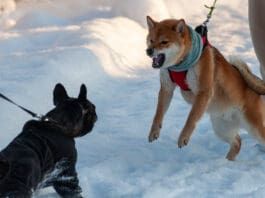What You Need to Know About Yellow Dogs and DINOS
I grew up around horses. In the horse world, if you tie a red ribbon in your horse’s tail, everyone knows that means your...
What Causes Aggressive Dog Behavior?
When dogs display aggressive behaviors, it’s rare for humans to consider whatever the dog was trying to communicate. Instead, the behaviors are just considered unacceptable, threatening, and dangerous. Look at it from their point of view, though.
Managing Dog-Aggressive Dogs in the Family
If you do nothing else about the aggression between your dogs, you must scrupulously manage their movements and activities. Every time your dog successfully engages in a behavior that you don't want her to exhibit, it makes it that much harder to convince her that it's not a useful behavior strategy. Every time your dog aggressively communicates to another canine family member, it increases the potential for unresolvable aggression between the two and serious injury to one or both.
Qualified Professionals for Dog Aggression Modification
Mild aggression cases might involve a dog who growls and might even air-snap
Fear Aggression in Dogs
Fear-related aggression most frequently appears between the ages of eight to 18 months, as a young dog reaches maturity. This may be because increased boldness tends to come with maturity. But it's also likely because, over time, aggressive responses are reinforced; the scary stimulus (most often a human, when we're talking about aggression issues) backs off. Initially, a fearful pup generally tries to hide from scary humans by moving away, perhaps crawling under a chair.
Dog Breed Stereotypes: Inaccurate and Damaging
Poor agreement was found between visual breed assignments and DNA results in 14 of the 20 dogs (70 percent). Moreover, there was low inter-rater reliability, meaning that the dog experts did not show a high level of agreement regarding breed assignments to the 20 dogs. More than half of the evaluators agreed on the predominant breed in only seven of the 20 dogs (35 percent). These results provide evidence that physical appearance is not a reliable method for breed identification.
Aggressive Behavior Information
It has become all too common to see lists of breed bans in multi-unit residences as well as municipalities. Books could be written about the drawbacks of breed-specific legislation (BSL), but suffice to say that all dogs have the potential to bite and no breed has 100 percent benign membership. The bully breed" lovers among us (count me in) would point out that many of these dogs are model citizens and great companions."
Could My Dog Be Racist?
Almost as soon as I walked into Boomer's house I could tell his owner was nervous. This isn't all that unusual when meeting a new client for the first time. I always have my new clients put the dog in another room so we can get acquainted with each other and have some time to chat without being distracted. Very often, the clients are uneasy during these initial consultations; I've grown accustomed to it. After all, often they have agonized over acknowledging their dog's issues and their decision to call in a professional. But after a few minutes, I could tell there was something more. I'd been called to help her dog with his reactive behavior. She related that he lunged and barked at some people as they walked by. During our discussion, she seemed unusually pensive and was having difficulty making eye contact with me. So I pressed, Is there anything else you need to tell me? Whatever it is
Unsticking Myths About Dogs
apprehensive
Behavior Medication Opens Doors
After about six weeks of living with Trill, Dr. Sharp knew that the frightened, anxious dog needed something more. The training and behavior protocols were working in the sense that the dog was cooperative, but Trill still had a panicked look in her eyes much of the time. Sharp was concerned: No animal should have to live with that much fear, she thought.
Solving Your Dog’s Behavior Problem Crisis
One of the most irritating and common phone calls I receive in my capacity as a professional dog trainer is when dog owners urgently ask me to help solve their dog's behavior problem immediately even though, as it often turns out, the problem has actually existed for years. Sometimes, it's even phrased as, If we can't get this fixed now
Peacekeeping Among Cats and Dogs
It's fairly common for dogs to be placed for adoption with a caveat that there should be no cats

















